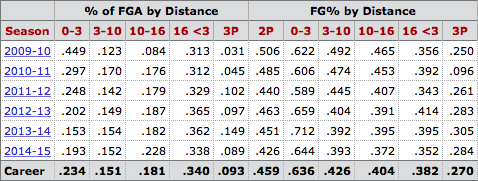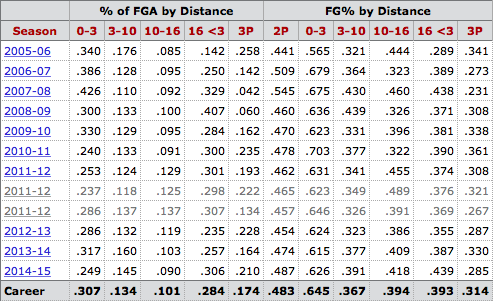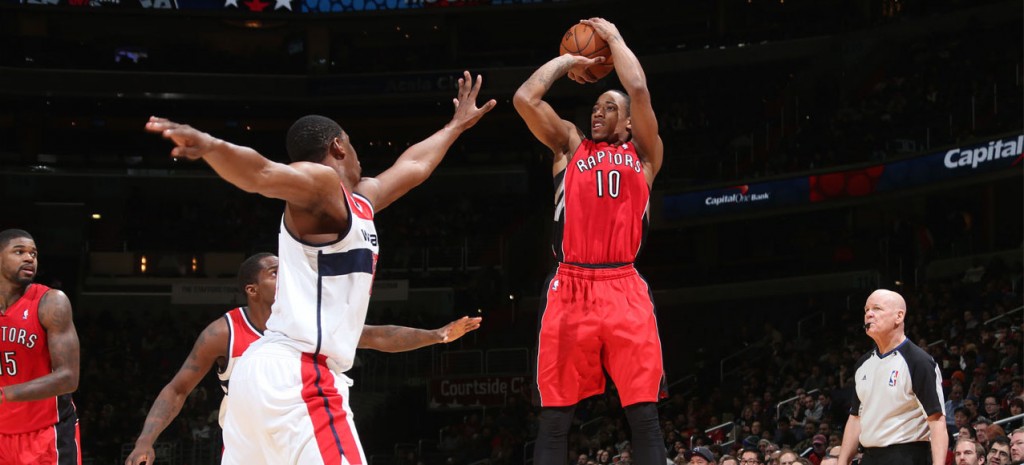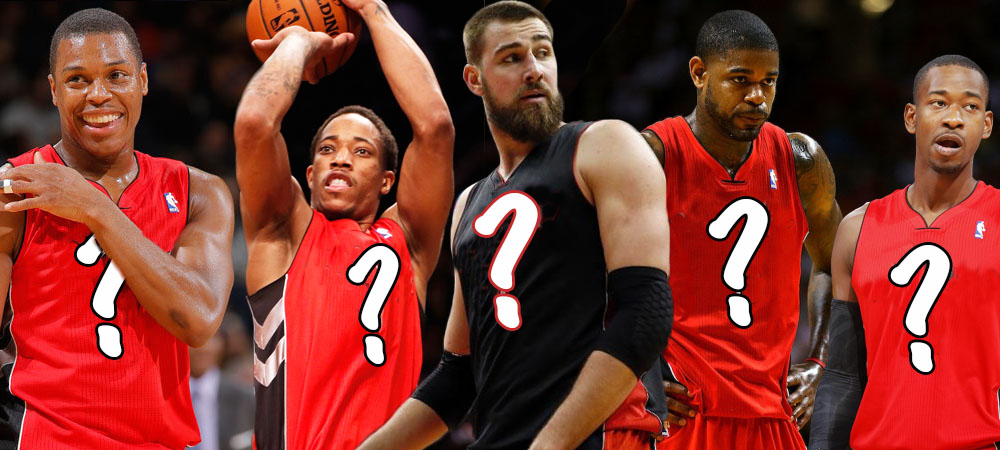(This article ended up longer than expected, so is being split into two parts)
After admitting you have a problem, and then realizing you have to do something about it, the next thing is to start to figure out what to do.
Now let me cut one argument off at the pass. When I suggest trading a player, I don’t mean at all costs (unless I say so, and I don’t see anyone on this roster who fits that category). Obviously you want a fair deal, but if there isn’t one out there then you don’t do it. But you jump on the first good trade.
KYLE LOWRY: Trade
Yes, he’s an All Star. Yes, he’s the emotional leader of the team. Yes, he single handedly won quite a number of games for the Raptors. He’s also all the things discussed here, which makes trying to build around him an exercise in futility. And it’s not just me saying this. CBS’s Matt Moore and James Herbert go into detail about the problems with the Raptors roster on the latest Eye On Basketball podcast and discuss both Lowry and DeMar DeRozan.
At 29, with his mentality and body type, keeping Lowry simply doesn’t make sense for a team in need of a major facelift. He’s got talent, that’s for sure, but the Raptors aren’t in a position to try and continue to make it work with him. A team that relies on him too much will have to put up with his inconsistency, and the Raptors’ lack of real talent means he will continue to be relied on heavily.
The challenge with trading Lowry is that his trade value is probably not very high after a disappointing second half of the season and poor playoffs. That’s not to say you can’t try. The problem with keeping him until his trade value goes up is that it then becomes tempting not to trade him. Especially if the team is playing well at the time. This is exactly what happened when Ujiri was set to trade him to the Knicks after the Rudy Gay deal. The team started clicking and winning and any plans went out the window.
Possible Targets: Sacramento, New York, Indiana, Lakers, Dallas, Houston
DEMAR DEROZAN: Trade
Let’s be clear here. I think trying to build around DeRozan is a monumentally bad idea. Worse than trying to build around Bosh, but not nearly as bad as trying to build around Bargnani. This franchise’s insistence on building around players that simply aren’t good enough is astoundingly frustrating. DeRozan is a quality shooting guard in a league with a dearth of quality shooting guards, but he should not be anything more than a third option (at best) on a good playoff team.
While DeRozan has averaged at least 20 ppg the last two seasons, he does so with a variety of inefficient shots. Just because you can score 20+ ppg doesn’t mean you should. DeRozan had the 10th highest Usage Percentage in the league, but wasn’t close to being the 10th most productive player on offense. And before you argue that he’s simply taking what the offense gives him, this is the same argument people used for Bosh and Bargnani’s inefficient offense. Players always revert to what they’re most comfortable doing, and with DeRozan that’s long jumpers. That’s what he’s always done.
Take a look at his shooting numbers:

The only season he didn’t shoot the vast majority of his shots from 16-20 feet was his rookie season, when he was the 5th option. While you expect percentages to drop with more responsibility, his percentages have dropped mostly because he’s simply shooting more from places he shouldn’t be. The only thing that allows him to be as efficient a scorer as he is is his ability to get to the line, something that was taken away in the playoffs by Washington.
Here are three other shooting guards’ shooting numbers:



(Stats courtesy of basketball-reference.com)
The first one is Monta Ellis, who has always had the reputation of a low efficiency gunner. He’s actually a more efficient scorer than DeRozan, despite the fact he’s almost as bad from three as DeRozan is (they actually had almost identical percentages this year).
The second one is Andrew Wiggins, who came into the league with similar strengths and weaknesses that DeRozan did. Wiggins was surprisingly decent from three, until it went south after the All Star break, and was far less efficient on his long jumpers, but still was able to shoot with far more efficiency because he took the majority of his shots where he could do the most damage: Within three feet.
Jimmy Butler is the third one. In Butler’s rookie season he was an even worse three point shooter than DeRozan, but improved enough that he’s now above average. What makes him efficient, though, is that he takes a third of his shots at the basket, compared to DeRozan, who takes less than 20% of his shots there. And Butler is a far superior defender, as is Wiggins.
While DeRozan has made improvements in his game every season, he’s still not a good shooter and a negative on the defensive end. At this point I don’t think Ujiri would even hesitate trading DeRozan for James Harden, Klay Thompson, Andrew Wiggins, Jimmy Butler, Giannis Antetokounmpo or even Bradley Beal (a more efficient scorer, better shooter and better defender).
DeRozan not being a top five shooting guard certainly isn’t a reason to trade him, but what is a good reason to trade him is that his offense is incongruous with anyone who doesn’t shoot well from three, especially Jonas Valanciunas (both players played better when the other was off the court). While it’s certainly possible to surround DeRozan with mostly three point shooters to take advantage of his strengths, he’s simply not good enough to warrant doing so, which was the case with Bosh and Bargnani.

So the best option is to trade him while his value is as high as it is (with a decent contract).
Possible Targets: Charlotte, Detroit, New York, Memphis, Phoenix, Utah
JONAS VALANCIUNAS: Keep
There’s no denying that Valanciunas has not progressed as most hoped he would. He’s also a bit of a statistical conundrum. Some advanced stats love him while he does poorly with others. He’s got the highest PER on the team (a very good 20.6), the third highest Offensive Rating on the team and the best Defensive Rating among rotation players, but the team is actually worse when he’s on the floor. Quite a bit, actually.
This says a couple of things. You can’t pick and choose what stats to look at, even advanced stats, and Valanciunas has probably not been put in the best situation, either through teammates that don’t compliment him or an offense that doesn’t take advantage of his strengths. Or in Valanciunas’ case, both.
And while he’s become a very good rebounder (11th in the league in rebounds per 100 possessions) and efficient scorer (8th in the league in True Shooting Percentage), he also has trouble getting the tough rebounds and is a black hole on offense. In fact, his assists per 100 possessions has actually gone down each of his three seasons and it’s not as if it was high to begin with. Watching him react against double teams is like watching “that guy” you play with at the rec centre try and bring the ball up the court on a fast break. You know something bad is going to happen, you just don’t know exactly what.
While his defense is not as bad as it appears, because he’s too often put in a bad situation by the perimeter players, he’s nowhere close to being good enough to anchor a defense. He’s not always where he should be and is slow to react. It seems as though the extra muscle he’s packed on has slowed him down too much and reduced what little explosiveness he had to begin with.
He’s certainly not afraid of hard work and his slow development isn’t for lack of trying. This alone makes holding onto him a good idea.
Probably the most important thing in Valanciunas’ favour, though, is the fact that he’s just 22 and has been in the league just 3 seasons. Although it’s becoming more and more difficult to see him developing into a top player in the league, giving up on him now would be VERY premature. Unless another team makes an offer you can’t refuse, although I don’t see that happening.
Keeping Valanciunas is not the only decision you have to make regarding him. This summer he is eligible for an extension, so the question is whether you want to extend one, or wait until next summer when he becomes a free agent and the market decides. Personally, I would offer somewhere in the $10-12 million per season range and if he declines, then wait until he becomes a restricted free agent. That amount isn’t outrageous for a 7 footer with his skill set and in line with what other similar big men are making. Especially considering the expected rise in salaries that will come with the higher salary cap in the next few years.
Things To Work On: Mobility, decision-making, defense, jumpshot
AMIR JOHNSON: Keep
Amir Johnson is clearly on the decline, and it’s a shame. In his prime, he was a guy any team would absolutely love to have and a coach’s dream. He works hard, doesn’t need the ball and does whatever he’s asked to do. And, when healthy, he’s a very efficient offensive player, good defender and a decent rebounder. Unfortunately, his willingness to do all the dirty work, no matter what the cost, has taken it’s toll and this past season has been one of the least productive of his career.
With his mobility hindered, his help defense, usually a strength, suffered, and that could have been one of the main reasons for the Raptor’s drop off in defense. It used to be that Amir had trouble playing heavy minutes because of foul trouble (he’s gone from 6.3 fouls per 36 minutes, in his first season with the Raptors, to 4.1 this past season). Nowadays he has trouble playing big minutes because of physical limitations.
So why should the Raptors keep him?
First off, let me be clear that I would only bring him back for a two or three year deal at a similar or slightly lower figure than he’s making right now. Barring a major physical turnaround, it’s hard to imagine him being a starter, anymore, and he probably shouldn’t be paid like one. Even if he doesn’t start, he’s the type of veteran influence you want around young players, especially your big men.
And if he does get back to his normal self, then all the better.
Things To Work On: Health
TERRENCE ROSS: Keep
Fans will often take for granted that young players improve every season when that’s not always the case. And Ross is the perfect example.
After a sophomore season that saw him become the Raptors’ full time starter at small forward, with a burgeoning defensive game and solid three point shot, the athletic Ross seemed poised for a bright future that was highlighted by a franchise-tying record 51 point game. Unfortunately, this season saw regression on both ends of the court, culminating in him being taken out of the starting lineup when the team started to struggle.
Ross still shot above average from beyond the arc, but he seemed to forget what made him a good defender last season and became almost allergic to the paint, resulting in the lowest free throw rate on the entire team (excluding Bruno Caboclo, who failed to take one free throw all season). Ross’ FTA/FGA ratio of .074 is even lower than Kyle Korver, who barely sets foot inside the arc on offense, and Danny Green, who I’m sure has been told never to dribble the ball and only shoot from 3. Not getting to the line isn’t a huge problem for a complimentary player like Ross, but he better bring other valuable skills to the table. Korver is possibly the best shooter in the league. Green is one of the best defenders. Ross was 55th in the league in three point shooting (behind Chris Bosh) and often looked disinterested on defense.
At this point, Ross has little trade value, so keeping him and hoping he realizes how close he is to being out of the league is probably the best course of action. Worse case scenario, Ross continues to regress and the Raptors can simply part ways next summer. Best case scenario, he bounces back and the Raptors can either trade him before the deadline or see what the market is for him when he becomes a restricted free agent. Like Valanciunas, Ross is eligible for an extension this summer, but unless we see a huge turnaround at training camp, I don’t see the point in offering him one.
Things To Work On: Playing hard, defense, shooting, finding out where the paint is.
Tomorrow we’ll look at the bench players and head coach, Dwane Casey.



